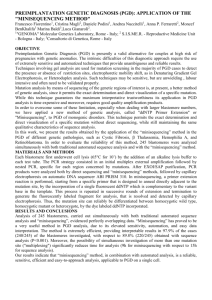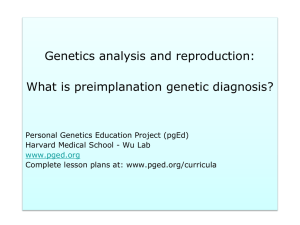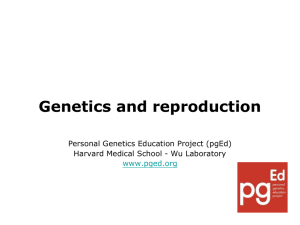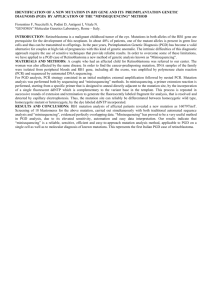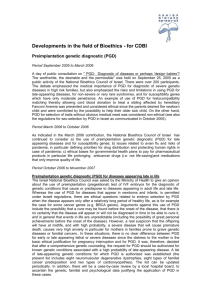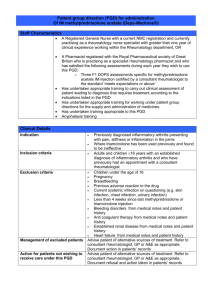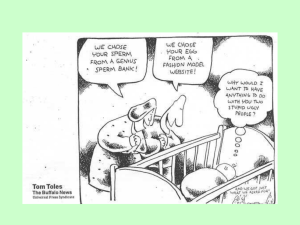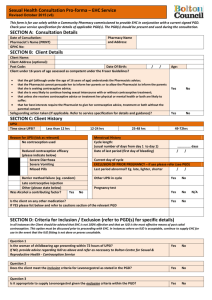nside the PGD Consortium
advertisement
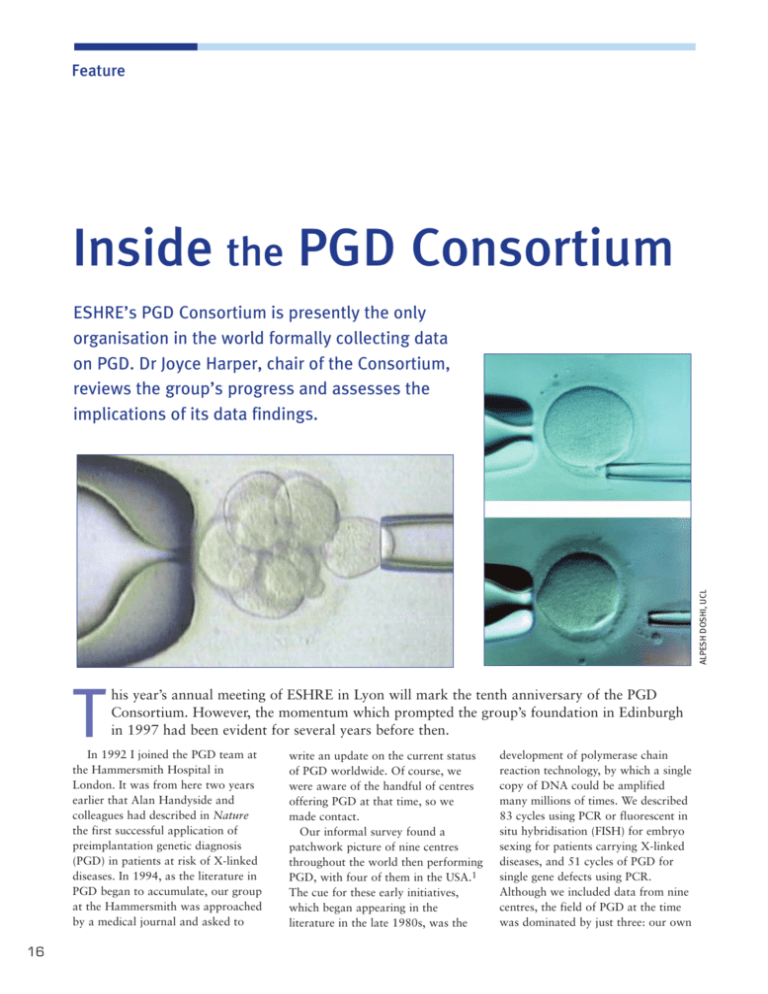
Feature Inside the PGD Consortium ALPESH DOSHI, UCL ESHRE’s PGD Consortium is presently the only organisation in the world formally collecting data on PGD. Dr Joyce Harper, chair of the Consortium, reviews the group’s progress and assesses the implications of its data findings. T his year’s annual meeting of ESHRE in Lyon will mark the tenth anniversary of the PGD Consortium. However, the momentum which prompted the group’s foundation in Edinburgh in 1997 had been evident for several years before then. In 1992 I joined the PGD team at the Hammersmith Hospital in London. It was from here two years earlier that Alan Handyside and colleagues had described in Nature the first successful application of preimplantation genetic diagnosis (PGD) in patients at risk of X-linked diseases. In 1994, as the literature in PGD began to accumulate, our group at the Hammersmith was approached by a medical journal and asked to 16 write an update on the current status of PGD worldwide. Of course, we were aware of the handful of centres offering PGD at that time, so we made contact. Our informal survey found a patchwork picture of nine centres throughout the world then performing PGD, with four of them in the USA.1 The cue for these early initiatives, which began appearing in the literature in the late 1980s, was the development of polymerase chain reaction technology, by which a single copy of DNA could be amplified many millions of times. We described 83 cycles using PCR or fluorescent in situ hybridisation (FISH) for embryo sexing for patients carrying X-linked diseases, and 51 cycles of PGD for single gene defects using PCR. Although we included data from nine centres, the field of PGD at the time was dominated by just three: our own group at the Hammersmith Hospital/UCL, the Reproductive Genetics Institute in Chicago, where Verlinsky and colleagues were already advocating first polar body biopsy, and Cornell in New York. This initial paper was well received and we were asked to repeat the process two years later.2 This time we collected data from 14 centres across the world, and again found that the majority of the 197 cycles reported to us had been performed for patients carrying an X-linked disease; 65 cycles had been performed for the diagnosis of single gene defects, mainly cystic fibrosis, using PCR. Overall, 50 pregnancies were reported (25% per cycle, 29% per transfer), with 28 deliveries and 34 babies born. The following year, 1997, at the Second International Symposium on Preimplantation Genetics held in Chicago, a number of us working in PGD agreed that a more formal collaboration among centres was needed for the systematic and longterm study of PGD. However, while we were sure that such a formal collaboration was necessary, we were less sure as to how it could be achieved. One possibility was in conjunction with ESHRE’s Special Interest Group in reproductive genetics - so we approached ESHRE and asked. The Executive Committee and the SIG agreed, and the ESHRE PGD Consortium was formally introduced at the annual meeting in Edinburgh that year as part of ESHRE’s SIG in reproductive genetics. For the papers published in 1994 and 1996 I had only asked centres for simple data on the number of PGD cycles, transfers, pregnancies, deliveries and the diseases being diagnosed. Now, however, we agreed that the Consortium would collect much more detailed information. Initially, centres completed paper forms which were put onto Excel by myself and a few of my team (I still have the forms gathering dust in my office). We then moved on to e- Aims of the ESHRE PGD Consortium • To survey the availability of PGD • To collect prospectively and retrospectively data on the accuracy, reliability and effectiveness of PGD • To initiate follow-up studies of pregnancies and children born • To produce guidelines and recommended PGD protocols • To formulate a consensus on the use of PGD mailing an Excel spreadsheet for centres to complete, and in 2002 Céline Moutou from Strasbourg developed a sophisticated FileMaker Pro database. The data collection has resulted in six publications to date, known as Data I, II, III, IV, V and VI. Data VII is currently being processed, but, on page 19, Karen Sermon from the VUB group in Brussels gives an outline of the latest returns. Cumulatively from Data I-VI we now have detailed information on 1760 cycles for monogenic diseases, 1736 for chromosome abnormalities, 750 for sexing for X-linked diseases, 4800 for aneuploidy screening and 334 for social sexing, all representing data on 1634 pregnancies and 1431 babies. This is the only international PGD database. The steering committee is now looking in more detail at some of the data, including our unique data on PGD for chromosomal abnormalities, which is being analysed by Paul Scriven from London. Misdiagnosis can be reported anonymously to the Consortium; so far, there have been 19 reported, of which Data VII will include a detailed analysis. Over the years the data collection has been very time consuming for the centres involved and for the steering committee responsible for correction and analysis. But the data do provide very useful information on the evolution and success of PGD. Changes in practice have been observed, such as the gradual increase in the use of laser for biopsy, the development of polar body biopsy in countries where cleavage stage biopsy is not permitted, the very recent appearance of blastocyst biopsy, the The initial steering committee formed in 1997 included from left to right Catherine Staessen, Joep Geraedts, Karen Sermon, Joyce Harper, Stéphane Viville, Inge Liebaers and Alan Handyside. 17 slow increase in the number of diseases amenable to diagnosis at the single cell level, and the huge increase in the number of cycles performed for aneuploidy screening. We have also seen an increase in controversial uses of PGD, such as sexing for social reasons, human leucocyte antigen (HLA) for tissue typing, and PGD for inherited cancers, such as BRCA1. When the first cycles of social sexing appeared, the Consortium debated whether they should be included in our publications, but, after consultation with ESHRE’s Special Interest Group in ethics and law, it was agreed that social sexing should be included. Another hotly debated topic in PGD has been the introduction of aneuploidy screening. PGD was originally developed as an alternative to prenatal diagnosis for individual couples at risk of transmitting a particular genetic or chromosomal abnormality to their children. But embryo biopsy and single cell diagnosis have also been used to help choose the best embryo for transfer in certain groups of patients, the majority of whom are infertile couples going through IVF. This includes patients of advanced maternal age, recurrent IVF failures and repeated miscarriages - but all of them parents with a normal karyotype. A five-probe FISH image for a normal embryo. Gold = X chromosome, blue = Y, green = 13, aqua = 18, and red = 21. The Consortium has been involved in two debates on this subject. The first is what to call it. One argument asks whether it is a screening, testing, or diagnostic method. It has in the past been referred to as PGDaneuploidy screening (PGD-AS), which surely makes no sense. Is it a screen or a diagnosis? Can it be both? Two camps emerged – those who wanted the procedure to remain under the PGD umbrella, and those who did not, claiming it is performed in a different group of patients with a different aim. Now, the term PGS has stuck, which in my view is totally inappropriate; we refer to it as ‘aneuploidy screening’ but PGS literally stands for preimplantation genetic screening. The second issue is whether PGS has any real advantage for patients. Just as with those early studies on blastocyst transfer or assisted hatching, so is it again incredibly difficult to perform prospective randomised controlled studies in patients undergoing these procedures. So the majority of reports do not support an adequate control group for comparison. The debate - still heated continues, as was apparent last year in Prague during an emotive ‘reevaluation’ session on PGS. That debate, incidentally, has now been put into some perspective by a recent Cochrane review, which, after finding only two eligible studies, concluded that ‘more properly conducted’ randomised trials are needed before any firm conclusions about efficacy can be made.3 However, as the box on page 17 shows, data collection is only part of the Consortium’s aims. After much consultation and discussion we were able to publish best practice guidelines in 2005, and these will be updated on a regular basis.4 Another study we are hoping to start in the next few months is the retrospective follow-up of the babies Data publication from the PGD Consortium The Consortium’s six data collections have all been published in Human Reproduction and represent the only international database of PGD information in the world. Calls have recently been made in the USA for the collection of US data. I. Geraedts J, Handyside A, Harper J, et al. ESHRE Preimplantation Genetic Diagnosis (PGD) Consortium: preliminary assessment of data from January 1997 to September 1998. ESHRE PGD Consortium Steering Committee. Hum Reprod 1999; 14: 3138-3148. II. Geraedts J, Handyside A, Harper J, et al. ESHRE Preimplantation Genetic Diagnosis Consortium Steering Committee. ESHRE Preimplantation Genetic Diagnosis Consortium: data collection II. Hum Reprod 2000; 15: 2673-2683. III. ESHRE PGD Consortium Steering Committee. ESHRE Preimplantation Genetic Diagnosis Consortium: data 18 collection III. Hum Reprod 2002; 17: 233-246. IV. Sermon K, Moutou C, Harper J, et al. ESHRE PGD Consortium data collection IV: May-December 2001. Hum Reprod 2005; 20: 19-34. V. Harper JC, Boelaert K, Geraedts J, et al. ESHRE PGD Consortium data collection V: Cycles from January to December 2002 with pregnancy follow-up to October 2003. Hum Reprod 2006; 21: 3-21. VI. Sermon KD, Michiels A, Harton G, et al. ESHRE PGD Consortium data collection VI: Cycles from January to December 2003 with pregnancy follow-up to October 2004, Hum Reprod (in press). Latest data from the PGD Consortium: Data VII The table to the right summarises the seventh data collection from the PGD Consortium. This collection covers cycle data from the year 2004, with pregnancies and babies born from these cycles. Forty-five centres sent in data, collectively on 3530 cycles. Of these, * 601 were for monogenic diseases (including HLA typing with and without monogenic disease) * 591 for chromosomal abnormalities * 104 for sexing for medical reasons * 2020 for PGS * and 95 for social sexing. In the large majority of cycles, ICSI was used for inseminating the oocytes. And, as first found in Data VI, zona drilling was primarily carried out by laser. Data were submitted on nearly 20,000 biopsied embryos, some 4200 of which were transferred in nearly 2400 embryo transfers. This led to 800 positive hCGs. Six hundred and ninety pregnancy records were submitted and 479 baby records. This year again, there were two misdiagnoses. These data are currently under scrutiny from the steering committee in preparation for publication. It is probable that, after selection, only a proportion of them will be of good enough quality to be reported. It is the continuous aim of the steering committee to improve the quality of the data collection. Cycles To OR Mono- HLA Chromos Sexing genic only abnormal for Xlinked 104 591 7 594 90 552 5 535 PGS Social sexing No code Total 2020 1977 95 80 119 117 3530 3356 IVF ICSI ICSI + FR ICSI + IVF AT Laser Mech Unknown 14 519 2 0 137 354 21 0 0 5 0 0 0 5 0 0 66 466 8 3 237 255 16 3 17 69 0 3 29 47 2 0 124 1795 6 48 364 1152 317 7 6 74 0 0 0 5 74 0 28 85 2 2 70 31 12 0 255 3013 18 56 837 1849 442 10 PBB CL ASP CL EX Blastocyst PBB + E FISH PCR 2 486 12 4 8 31 486 0 5 0 0 0 0 5 5 484 22 0 0 510 1 0 76 2 0 0 78 1 323 1489 28 0 0 1839 1 0 5 74 0 0 79 0 1 108 4 0 0 108 5 331 2653 142 4 8 2645 499 COC Biopsied ET-able ET-ed ETs 7320 3105 1429 802 416 54 25 2 0 0 8062 3774 853 609 362 1175 464 150 94 62 23560 11287 3940 2511 1425 1081 519 230 120 59 1533 646 173 121 72 42785 19820 6777 4257 2396 +ve hCG % +ve FHB % 138 33 104 25 0 0 0 0 112 31 91 25 23 33 20 32 490 34 363 25 20 34 16 27 17 24 15 21 800 33 609 25 Key OR = oocyte retrieval ICSI + FR = ICSI and frozen embryo transfer AT = acid Tyrodes drilling PBB = polar body biopsy CL ASP = cleavage aspiration CL EX = cleavage extrusion PBB + E = polar body biopsy with embryo biopsy FISH = fluorescent in situ hybridisation PCR = polymerase chain reaction COC = cumulus oocyte complex Of the 690 pregnancy records received, 331 resulted in singleton deliveries, 100 in twins, and two in triplets. Of the 479 baby records received (from 31 centres), 521 children were born, 266 males and 294 females (with data missing for 12). The mean birthweight for the singletons was 3178 grams, for the twins 2333 grams and for the triplets 2017 grams. Overall, a positive fetal heartbeat was recorded in 25% of the total 3530 recorded cycles. Karen Sermon, PGD Consortium Chair 1998-2006 19 Chairs, deputies and steering committee of the PGD Consortium 1997 - 1998 1998 - 2006 2006 - Chair Alan Handyside Chair Karen Sermon Chair Joyce Harper Deputy Chairs Karen Sermon and Joyce Harper Deputy Chairs Joyce Harper and Joep Geraedts Deputy Chairs Karen Sermon and Alan Thornhill 2006-07 Steering committee Joep Geraedts, Netherlands Stéphane Viville, France Christine de Die, Netherlands Leeanda Wilton, Australia born after PGD. This project is being co-ordinated by Alison Lashwood from London and takes the form of a questionnaire which participating centres will send to couples with a PGD baby. This will be the only study of its kind. In the near future we hope to initiate a prospective study. The Consortium has an informative web site (www.eshre.com/emc.asp? pageId=389), which includes all our publications, those centres registered with the Consortium and the diseases they diagnose, and information about training. As well as several workshops in Brussels, we last year held our first postcongress PGD workshop in Prague, and our first basic genetics workshop for ART specialists in Brussels. In Lyon this year Consortium members will be invited to a trouble-shooting day to discuss experiences in embryo biopsy. There are currently 75 centres registered with the Consortium. This includes most European centres, but additionally centres from Argentina, Australia, Brazil, Egypt, India, Israel, S. Korea, Taiwan, Turkey and USA. This reflects the international standing of the Consortium. Contributing centres receive the raw data of all centres in an anonymous format. An annual meeting of Consortium members takes place on the Saturday afternoon before the annual ESHRE meeting. Topical issues are discussed at what has now become a very valuable gathering. Last year in Prague topics included the possibility of PGD accreditation, the clinical 20 Paul Scriven, UK Gary Harton, USA Céline Moutou, France Alison Lashwood, UK value of PGS, and developments in quality assessment (being co-ordinated by Alan Thornhill, UK, and Sjoerd Repping from the Netherlands, in collaboration with Ros Hastings, who runs the UKNEQAS). Some of the Consortium are members of other committees. For example, we had several meetings with the European Society of Human Genetics during 2004 and 2005 to discuss the interface between ART and genetics; a comprehensive document with recommendations was published.5,6 Karen Sermon and others are involved in a survey of PGD in Europe with the Institute for Prospective Technological Studies (IPTS) and the European Science and Technology Observatory (ESTO) network, and ESHRE. Setting up and running the Consortium has taken up a significant amount of time. Karen Sermon was chair from 1998 to 2006 and was instrumental in the group’s efficient organisation and development. Karen is now co-ordinator of ESHRE’s SIG in reproductive genetics. ESHRE, aware of the huge efforts many of us have contributed, last year employed Veerle Goossens as scientific officer to help with some of these duties. This year the Consortium is celebrating its ten-year anniversary. Despite the controversies and the publicity, it’s my view that there have been no major changes in PGD over the past decade; but I feel that over the next ten years we may see some interesting developments. Sioban SenGupta, UK Sjoerd Repping, Netherlands Joanne Traeger-Synodinos, Greece Katerina Vesela, Czech Republic William Kearns, USA Dr Joyce Harper is Reader in Human Genetics and Embryology at the Centre for Preimplantation Genetic Diagnosis at University College London. A member of ESHRE’s Executive Committee, she became Chair of the PGD Consortium in 2006. References 1. Harper JC, Handyside AH. The current status of preimplantation diagnosis. Cur Obstet Gynaecol 1994; 4: 143-149. 2. Harper J. Preimplantation diagnosis of inherited disease by embryo biopsy: an update of the world figures. J Assist Reprod Genet 1996; 13: 90-95. 3. Twisk M, Mastenbroek S, van Wely M, et al. Preimplantation genetic screening for abnormal number of chromosomes (aneuploidies) in in vitro fertilisation or intracytoplasmic sperm injection. Cochrane Database Syst Rev 2006 Jan 25; (1): CD005291. 4. Thornhill AR, De Die-Smulders CE, Geraedts JP, et al. ESHRE PGD Consortium best practice guidelines for clinical preimplantation genetic diagnosis (PGD) and genetic screening (PGS). Hum Reprod 2005; 20: 35-48. 5. Soini S, Ibarreta D, Anastasiadou V, et al. The interface between assisted reproductive technologies and genetics: technical, social, ethical and legal issues. Eur J Hum Genetics 2006; 14: 588-645, and Human Reproduction Monographs: PGD in Europe, Number 1, 2006. 6. Recommendations of the European Societies of Human Genetics and Human Reproduction and Embryology. The need for interaction between assisted reproduction technology and genetics. Eur J Hum Genet 2006; 14: 509-511.
